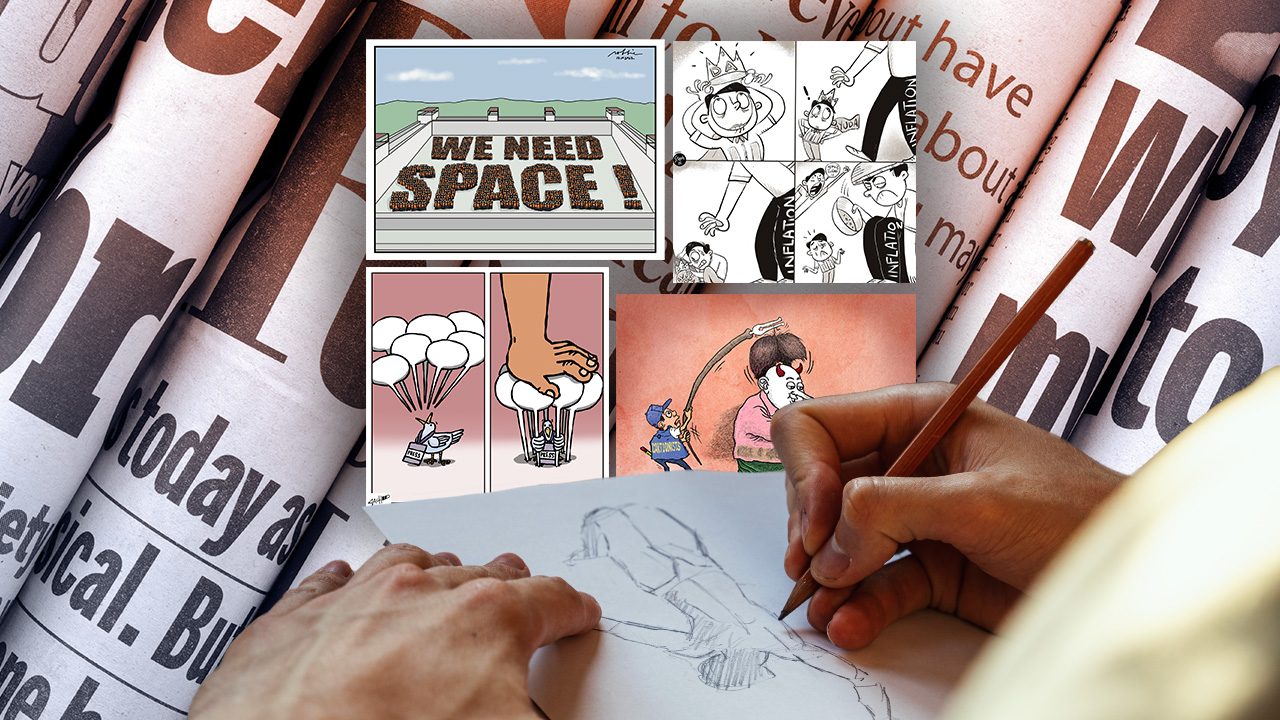SUMMARY
This is AI generated summarization, which may have errors. For context, always refer to the full article.

Cartoons have been a powerful way to convey a stand on issues and a call to action. But in today’s digital age, cartoonists are facing a pressing problem.
In an interview with Rappler, cartoonists Zach and StephB, described the murky situation of editorial cartooning in the Philippines.
For one, editorial cartoons were removed in at least two major print publications in 2022. First, The Philippine Daily Inquirer scrapped editorial cartoons in March. This was followed by The Philippine Star, which also ended the inclusion of editorial cartoons in its op-ed pages in August.
“Cartoons used to be one of the most anticipated in major publications–Philippine Star, Inquirer. You will notice that the pages in the newspapers are getting thinner and thinner. Because of cost-cutting, because social media is also rising. So one of the first casualties was the cartoon, cartoonists were the first removed,” Zach said in a mix of Filipino and English.
He also pointed out how some publishers avoid controversial cartoons that would pose conflict to some political interests.
This has pushed cartoonists like Zach and Steph to use the digital platform as a new avenue to promote their work.
“Akala siguro nila– some newspapers, na hindi ganun ka importante yung cartoons, pero, I think social media proves otherwise, na alam mo na grabe yung engagements, grabe yung reception ng mga tao. (Some newspapers thought that cartoons were not important, but I think social media proves otherwise, because you know, the engagements and the receptions from people were really enormous),” Zach added.
But for Steph, social media as a wider platform also brings its own set of challenges to remain relevant online.“Since ang kakumpitensya mo ngayon is the whole world ‘di ba? Yung hindi lang dito sa Pilipinas…. kailangan medyo iimprove mo lagi ang sarili mo para manotice ang artwork mo. Mas malaki na ngayon ang playing field eh (Since you have a bigger competition worldwide, you need to also improve yourself as a cartoonist so your artwork will stand out from the rest. The playing field has become bigger),” Steph said.
Regardless of the boost that social media can give to their work, Zach, meanwhile, expressed that editorial cartooning is a profession that must be balanced along with other jobs in order to meet the costs of living.
“There are no full-time cartoonists in the Philippines. It is always necessary to have a side job. If you are an artist, you are not only a cartoonist, but also a graphic artist, you do the layout too. Because you need to make a living, the challenge is you cannot be a full-time cartoonist,” he said in a mix of Filipino and English.
“Social media has a huge potential. But of course, artists have to pay their bills so it is necessary to balance with other passions you love,” Zach added.
Call for support
Despite these challenges, cartoonists like Zach and Steph managed to keep the art alive. They mentioned the importance of belonging to an organization such as Pitik Bulag, an artist-collective co-founded by Cartoonist Zach, which aims to provide aspiring cartoonists a platform to showcase their works on sociopolitical issues.
According to them, such organizations serve as a strong foundation of support, encouragement, and motivation necessary for them to accomplish more as cartoonists.
“I think because I’m part of an organization, I’m able to take part, and also join exhibits, collaborations and such- which on my own, If I’m not a part of a group, perhaps, I will not be able to do,” Steph, who is the only female member in the group, said in a mix of Filipino and English.
Both of them also added that their followers’ simple act of recognizing and sharing their works on social media can make a big difference to further amplify their advocacies and awaken people’s consciousness towards pressing issues.
“Sa pamamagitan ng paggawa ng cartoons meron kang abilidad… para isiwalat ano yung mensahe mo, ano yung gusto mo ipahiwatig tungkol sa mga issue na napapanahon. (Through creating cartoons, you have the ability…to reveal your messages, the things you wanted to share on issues that are relevant in our time),” Zach said.
This is especially important, according to Zach, because even if cartoons portray an issue at a certain time, its significance cannot be buried in the past.
“Marami sa mga martial law or mga lumang cartoons na hanggang ngayon ay super relevant pa rin. (Most old cartoons, and those released from the Martial Law period are still relevant up to this day) And that’s a manifestation of a good cartoon. It’s a timeless concept,” Zach added.
Alongside its timeless value, Steph added that cartoons also create an instant connection among its audience beyond words.
“I guess the editorial cartoon, for example, I will illustrate without words – if I do it well, someone from Iran or Japan will understand it, anyone who doesn’t speak English or Tagalog, they will understand. That’s how powerful it is,” Steph said in a mix of Filipino and English.
That is why for both of them, editorial cartooning still plays a very important role in journalism and upholding press freedom, especially in today’s online landscape.
“I know the importance of facts. So before making a cartoon, like I said before, I make sure na I do my research…. Facts help a lot pag gagawa ka ng isang illustration or editorial cartoon,” Steph said, highlighting the importance of facts in creating editorial cartoons and its influence on people’s perception.
They also called for support from Filipinos so they can continue to do the work that they do.
“In this age of disinformation, many people share false information. I want to make something different because art has the ability to instill awareness in people. It has the ability to mobilize, to arouse people’s political consciousness,” Zach said.– with reports from Angelica Coleto/Rappler.com
Angelica Coleto is a Rappler intern from the Polytechnic University of the Philippines – Sta. Mesa. She is currently a senior taking up a Bachelor of Arts degree in Literary and Cultural Studies.
Add a comment
How does this make you feel?
![[DECODED] The Philippines and Brazil have a lot in common. Online toxicity is one.](https://www.rappler.com/tachyon/2024/07/misogyny-tech-carousel-revised-decoded-july-2024.jpg?resize=257%2C257&crop_strategy=attention)




![[Rappler’s Best] Welcome to the battlefield](https://www.rappler.com/tachyon/2024/05/maria-ressa-harvard-scaled.jpeg?resize=257%2C257&crop=133px%2C0px%2C1920px%2C1920px)


![[OPINION] Social media and limits of protected speech](https://www.rappler.com/tachyon/2024/04/TL-badoy-red-tagging-2-apr-27-2024.jpg?resize=257%2C257&crop=327px%2C0px%2C720px%2C720px)
![[OPINION] Badoy’s red-tagging and freedom of expression](https://www.rappler.com/tachyon/2024/04/20240426-Badoy-red-tagging-freedom-expression.jpg?resize=257%2C257&crop_strategy=attention)




![[OPINION] You don’t always need a journalism degree to be a journalist](https://www.rappler.com/tachyon/2024/06/jed-harme-fellowship-essay-june-19-2024.jpg?resize=257%2C257&crop=287px%2C0px%2C720px%2C720px)
There are no comments yet. Add your comment to start the conversation.